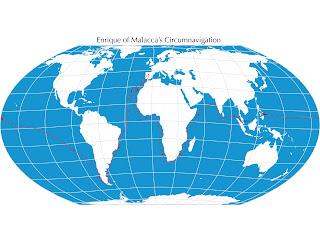 |
| 1840s illustration of Patagonians. |
Written by Antonia Pigafetta, chronicler who sailed with Magellan's armada.
When those people feel sick at the stomach, instead of purging themselves, they thrust an arrow down their throat for two palmos or more and vomit [substance of a] green color mixed with blood, for they eat a certain kind of thistle.
When they have a headache, they cut themselves across the forehead; and they do the same on the arms or on the legs and in any part of the body, letting a quantity of blood. One of those whom we had captured, and whom we kept in our ship, said that the blood refused to stay there [i.e., in the place of the pain], and consequently causes them suffering.
They wear their hair cut with the tonsure, like friars, but it is left longer; and they have a cotton cord wrapped about the head, to which they fasten their arrows when they go hunting. They bind their privies close to their bodies because of the exceeding great cold.
When one of those people die, ten or twelve demons all painted appear to them and dance very joyfully about the corpse. They notice that one of those demons is much taller than the others, and he cries out and rejoices more.
They paint themselves exactly in the same manner as the demon appears to them painted. They call the larger demon Setebos, and the others Cheleulle. That giant also told us by signs that he had seen the demons with two horns on their heads, and long hair which hung to the feet belching forth fire from mouth and buttocks.
The captain-general called those people Patagoni. They all clothe themselves in the skins of that animal above mentioned; and they have no houses except those made from the skin of the same animal, and they wander hither and thither with those houses just as the Cingani do.
They live on raw flesh and on a sweet root which they call chapae. Each of the two whom we captured ate a basketful of biscuit, and drank one-half pailful of water at a gulp. They also ate rats without skinning them.
Part 1. First Contact Patagonia: Magellan and the Patagonians, Pigafetta 1
Part 2. Giants and Guanacos: Magellan and the Patagonians, Pigafetta 2
Part 3. Giant John: Magellan and the Patagonians, Pigafetta 3

